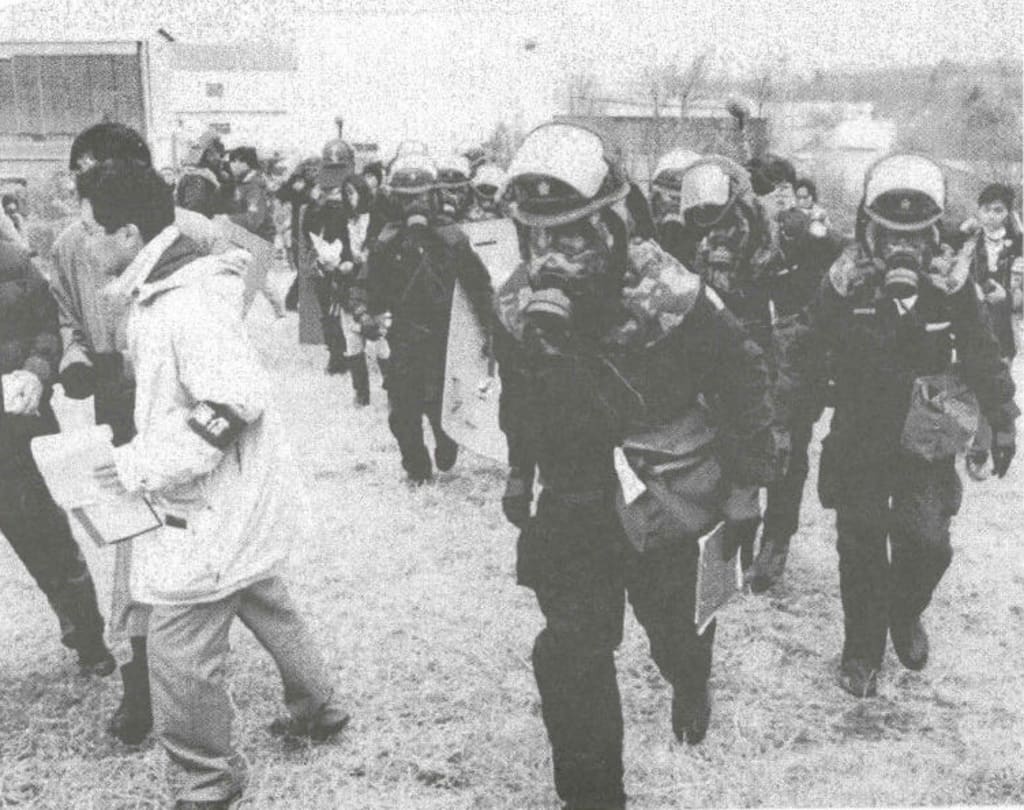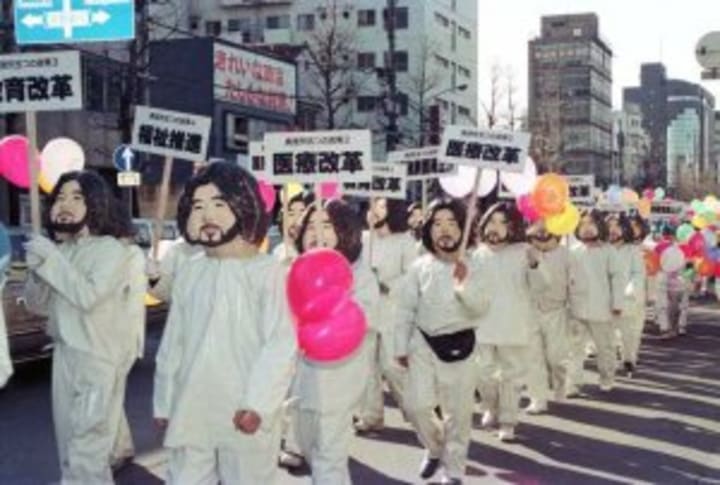The Rise and Fall of Japan's Doomsday Cult, Aum Shinrikyo
Founded in 1984, Aum Shinrikyo perpetuated two sarin gas attacks that killed multiple people

Aum Shinrikyo (Supreme Truth) is a doomsday cult that began in 1984 by Shoko Asahara. Aum (its common name) is responsible for two sarin gas attacks and multiple murders and kidnappings.
At its peak, Aum Shinrikyo had tens of thousands of worshipers worldwide and is responsible for the worst domestic terror attack ever carried out on Japanese soil. On March 20, 1995, the attack carried out on the subway killed 13 and injured 5,800, some permanently.
Shoko Asahara's Humble Beginnings
Born Chizuo Matsumoto into a low-income family in 1955. Matsumoto lost most of his eyesight from childhood glaucoma (like Ray Charles). His family sent him to live in a home with other vision-impaired youth. Because his vision was better than his classmates', he bullied them. He became both feared and followed. This experience set up his ability to get others to follow him.
A Sign of the Future
Matsumoto loved sci-fi and claimed that he would rule a robot army one day. After leaving the home for vision-impaired children, he applied to college but was rejected and began practicing acupuncture and yoga (both common careers for the blind in Japan). At this time, he also discovered the writings of Nostradamus, a 16th-century French astrologer, and physician who created extensive writings about the end of the world.

Matsumoto became obsessed with the idea of Armageddon. He began to have visions of the end of the world while meditating, and he believed he'd been chosen to build an army to bring about the end days.
Matsumoto claimed he was the Reincarnation of Christ and the first enlightened one since Buddha, and only he and those who followed him would survive the apocalypse to rule the world. It is around this time that Matsumoto becomes Shoko Asahara.
Rush hour of the gods
Many Japanese people feel they are Shinto at birth, Christian at marriage, and Buddhist at death. Each religion lends itself to an aspect of life. Shinto is rich in birth rituals, Christianity offers glamorous weddings, and Buddhism, with its belief in reincarnation, lends itself well to funerals.
After World War II, occupying American forces sought to squash the ultra-nationalism they felt contributed to militarism in Japan. They did away with state-sponsored Shintoism. The imposition of religious freedom led to thousands of new religious movements. This religious freedom has been coined "rush hour of the gods." Quickly, the tax exemption status for new religions became corrupt. Politicians used donations as a means of finding new voters, exploiting loopholes. When Aum Shinrikyo was recognized as a religion in 1989, it used its new status to further its goals.
The Start of Aum Shinrikyo
Asahara began preaching about his visions that announced that the end times were near but needed to be ushered in. The teacher-student dynamic placed Asahara in a place of power, making him more dangerous.
Aum Shinrikyo, which was a blend of mysticism, yoga, Christianity, Buddhist, and Hinduism, took off in 1984. One of Asahara's and his follower's biggest claimes was that they could levitate.
Asahara actively recruited scientists, lawyers, and other highly trained individuals along with a smattering of ex-gangsters. Some of these highly trained individuals would create weapons of mass destruction for Aum.
Delusions of Grandeur
Asahara started making videos about his destiny to lead the world to the second coming, where he'd rule. His target demographic was the well-educated but lost individuals who felt disillusioned by their work. In Japan, society measures people by their academic test scores, not their individual achievements. Asahara attempted to indoctrinate scientists and engineers who sought meaning in their lives. If they followed him, they would find a path to salvation in the new world to come. However, that world could only come to pass if they destroyed the current one.

By 1990, Aum Shinrikyo had over five thousand followers in Japan. Asahara ordered his engineers to develop a wired helmet for inductees that would align their brainwaves with his own. He called the helmets PSI — Perfect Salvation Initiation. He also ordered followers to wear masks of his likeness and worship him while they wore them.
Followers paid Asahara thousands of dollars to bless them, drink his blood, tea brewed from his hair, and wear the PSI helmets.
Aum Shinrikyo’s Run for Public Office
In 1990, Asahara and 26 of his followers ran for the Japanese parliament. They conducted a singing and dancing campaign, which didn't do them any favors. When they failed to land a single seat in parliament, Asahara became even more despondent with Japanese society.

Things Take a Turn for the Worse
Aum Shinrikyo set up shop in a remote farming community. Inside the farm, followers underwent survival training. The training became dangerous. People were submerged in hot baths and not allowed to breathe or were buried underground in a bunker for six days. Drugs were used to heighten and then dispel anxiety, preparing them for the attack. Some died, and their remains cremated. Others were murdered for challenging the group or for trying to leave.
Asahara showered loyal followers with praise.
Other forms of mind-control consisted of hours of chanting and listening to recordings of Asahara tell them the pain they felt was an illusion and that their training would remove all bodily and mental discomforts.
Aum Shinrikyo's Bid for Other Countries
In 1992 Asahara went to Moscow to open another branch of Aum Shinrikyo. With the fall of the Iron Curtain, many searched for greater meaning in their lives. 30,000 Russians joined. All members gained training with a Russian Paratroop regiment, learning to fire automatic weapons, explosives, and drive tanks.
Aum Shinrikyo planned on using the Ak-47 as a model for creating their own guns. They bought a used airplane from the Russian government for $1 million and used it to train.
Aum Shinrikyo begins to create weapons of Mass Destruction
A 30-year-old engineer created the sarin manufacturing plant. He was looking for a union between science and religion. In an interview weeks before the 1995 attack, he stated that he had 100% faith in his leader.
Through dummy corporations, the group managed to amass barrels of toxic chemicals to create sarin.
On the farm, Aum Shinrikyo began experimenting with creating sarin gas and other neurotoxins. Residents noticed and supplied the authorities with over a million pictures of followers engaging in non-religious activities. The authorities did nothing with this information. One morning at 4 a.m., area residents rushed the compound as noxious fumes leaked out. The officers waited two weeks before inspecting the factory. By then, no evidence of anything nefarious remained.
The group then sought a more remote area for their work and bought a piece of land in Western Australia in September 1993.
Their activities still didn't go unnoticed. Airport security detained a few members for transporting controlled chemicals. However, they didn't notice a prototype of sarin gas hidden in 30 glass sake bottles. They proceeded to test the gas on neighboring sheep.
Kidnappings and Disappearances
In 1989, an anti-cult lawyer, Tsutsumi Sakamoto, filed a claim against Aum, but the courts dismissed it. He and his family later went missing. The police had little to go on, and the case remained unsolved until the 1995 subway attacks when authorities discovered the cult had murdered the Sakamoto family.
Assassination Attempts and Considerations
Over the years, the cult has considered several assassinations against those critical of the group, including heads of Buddhist sects Soka Gakkai and The Institute for Research in Human Happiness. Cartoonist Yoshinori Kobayashi began satirizing the cult, Aum added him to their hit list. Aum made an assassination attempt on Kobayashi in 1993.
Members were forced to give a detailed list of their holdings, car, homes, jewelry, etc., and told to sign them over to the cult. One woman escaped with the help of her brother and went into hiding only to have her brother murdered. Aum injected him with a lethal dose of anesthetic in an attempt to get him to divulge the whereabouts of his wealthy sister. Followers cremated the man's body and scattered his ashes in a lake.
Aum Shinrikyo Anthrax Attack Attempt
From the roof of the cult's Tokyo headquarters in July 1993, members distributed large amounts of a liquid containing Bacillus anthracis. The attempt to cause an anthrax outbreak failed. However, a large number of complaints about foul odors were reported. Luckily no one got sick.
A Need for Organization
As a group, they had the terror thing down but lacked leadership as an organization. They actively began recruiting those in leadership roles in the government.
They began to get membership from Japan's military. Soldiers help steal military secrets for biological and nuclear weapons. They also formed the Command Unit to assassinate the Emperor.
Aum Shinrikyo Sarin Attacks
MATSUMOTO, NAGANO
On June 27, 1994, Aum carried out a chemical weapons attack against civilians in the central Japanese city of Matsumoto, Nagano. With a converted refrigerator truck, cult members released sarin near judges' homes oversaw a real-estate dispute concerning the cult. Eight people died in the attack and 500 more injured, some permanently. Police focused their investigation on a resident, Yoshiyuki Kouno. After the Tokyo subway attack, authorities discovered that Aum Shinrikyo was behind the Matsumoto sarin attack.

Symptoms of the gas were blurred vision, nausea, and hallucinations.
By this time, the public was more and more distributed by the cult. People wanted to know where their family members were and what had happened to them.
TOKYO SUBWAY
Three days before a raid on the plant, Asahara received a tip that investigators were onto him. Asahara ordered his followers to distribute plastic bags filled with liquid sarin and a chemical to convert it into gas across Japan. On March 20, 1995, followers bordered trains packed with commuters. All trains were heading to Tokyo's central government district. Just after 8 a.m., five plastic bags wrapped in newspapers were placed on the floor of the trains and punctured with the end of an umbrella.
The attack killed 13 people and injured 5,800 more. Asahara and his followers were arrested and charged with multiple counts of murder. The low number of dead saddened Asahara.

After the Aum Shinrikyo Attacks
In the months after the March 1995 sarin train attacks, members of Aum tried to release hydrogen cyanide gas into several metro stations but failed.
Asahara and 13 followers received death sentences. In 2018, Asharar was hanged, 23 years after the subway attack. Japan does not allow witnesses to view executions. Viewing occurs afterward. In addition, the Japanese authorities don't inform the public or family members of executions before they happen. 80% of Japanese citizens support the death penalty.
After the attacks and arrests, the Japanese government banned the Amu sect from practicing and labeled it a terrorist group. However, members claim to follow Asahara's teachings still.
The remaining followers took the cult underground, eventually renaming Aum Aleph. In 2007, Ashahara's successor Fumihiro Joyu created a smaller group called Hikari no Wa, which means Circle of Rainbow Light.
Hikari no Wa and Aleph remain legal groups in Japan.
A/N: This article initially accompanied the Demiworld Podcast episode on Religious Cults.
More Articles Like This
If you'd like to support writers, considere signing up for a Vocal.Media membership.
About the Creator
Cynthia Varady
Aspiring novelist and award-winning short story writer. Hangs at Twtich & Patreon with AllThatGlittersIsProse. Cynthia resides in Portland, Oregon, with her husband, son, & kitties. She/Her






Comments
There are no comments for this story
Be the first to respond and start the conversation.